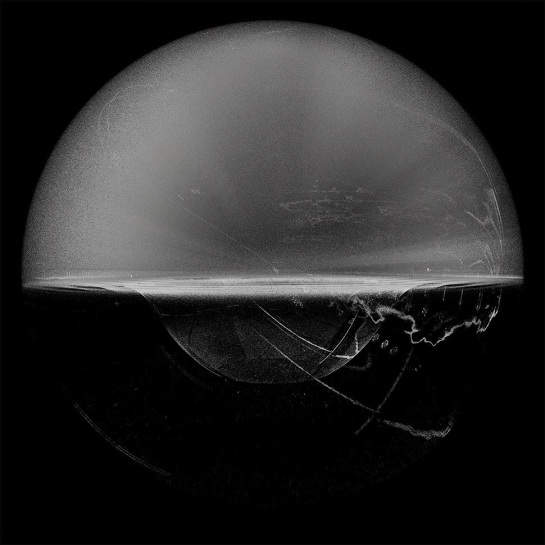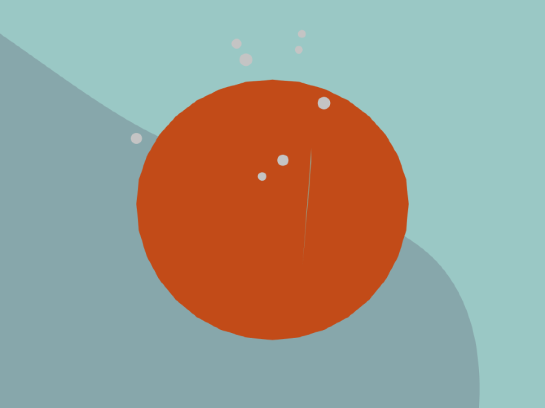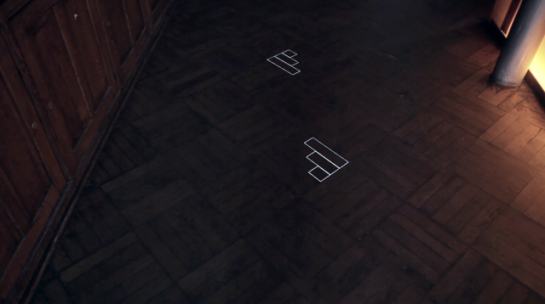
Beyond Tinted – Մգեցված ապակիներից այն կողմ
Beyond Tinted
Dickie Webb
A new body of work by artist Dickie Webb brings together intermedia works that investigate our current connection to the Yerevan landscape and beyond. These experimental works draw from liminal sites and objects that are used to manage space. Webbs’ process abstracts and subverts these findings, utilizing photography, sculptural elements and new media technologies; it is the anthropomorphic qualities that underscore the works. Just like liminal space these works exist in an unknown state, straddling both real and virtual, Webb does not imply directly what they mean rather he suggest they are a means to reflect on the potential of what could be. These works challenge especially that part of local people that have to reconsider their present landscape and gain some form of clarity out from behind their tinted view (tinted glasses of the big cars of nоuveau riche). The final works vary in fabrication and are part of a wide palette that enables Webb to present intimate moments, to view our present existence from an altered perspective and reflect on our own being.
Artist Statement:
Dickie Webb operates his art practice from the position of a wanderer, moving consistently over the years, dislocating himself from societal norms. With few constants Webb’s peripatetic lifestyle means he has had to adapt and rethink our connection to landscape, altering his comprehension of what is considered home and the role of society’s expectations.
Examining our existence Webb questions that which is real and what is otherwise virtual within our landscape, utilising Marc Auges’ “non-places” and Michel Foucaults’ “heterotopias” as initial starting points. Webb uses these imaginary and transient sites as a means to reveal anomalies, inaccuracies similar to those displayed within human personalities.
This connection to space through its anthropomorphic qualities prompts Webb to consider space as representational of current issues experienced within both the individual and collective. Using space as a metaphor and as a medium Webb looks past the architectural structure and explores the liminal qualities, discovering this blurred arena from an outsider’s perspective.
Processes:
Interactive installations, Arduino, photography, site-specific installation, sculpture, print, sensory based media light, sound and scents, interventions, casting, drawing, constructive and destructive processes.
Materials:
Paint, plaster, bronze, aluminium, soap, salt, concrete, sugar, ice, glass, steel, wood, resin, ink, milk and wax.
Objects:
Cardboard boxes, furniture, envelopes and car windscreens.
————————–
Born in 1979, in Oxford, United Kingdom. Dickie Webb currently divides his time between New Zealand, USA and the UK. Webb studied for a BA Honours in Intermedia at Edinburgh College of Art; part of his degree was spent at the State University of New York, Purchase College. Prior to his degree Webb studied at Oxford Brookes University, UK. Since graduating Webb has continued travelling working in Japan, New Zealand and Chile whilst also undertaking artist residencies in Athens, Greece (SNEHTA) and currently here in Yerevan (ACSL). He has exhibited works in the UK, USA and Greece.
Recent Exhibitions:
2014 THINGS ARE DIFFERENT NOW – Art Athina, Athens, Greece
2014 Boundaries – Artscapes, Athens, Greece
2013 Unsettled Certainties – Aghias Zonis 1 Space, Athens, Greece.
2013 One Action, Ones Actions – Cultybraggan POW Camp, Perthshire, UK
2013 Newhaven Station – Edinburgh, UK
The exhibition is organized by the Art and Cultural Studies Laboratory (ACSL). This project is realized at the [Art Commune] International Artist-in-Residence Program (ACSL)
This project is funded by European Cultural Foundation
Special thanks to the Yerevan Modern Art Museum, director of the Museum Nune Avetisyan and its staff.
________________________________________________________________________
Մգեցված ապակիներից այն կողմ
Դիքի Վեբբ (Անգլիա)
Արվեստագետ Դիքի Վեբբի Հայաստանում իրականցված այս նոր նախագիծը քննության է առնում Երեւանի շրջակա միջավայրի, դրանում առկա այլ քաղաքատեղերի հետ հընթացս կապերը: Բազմամեդիական եւ փորձարարական ոգով տոգորված աշխատանքները մտորումներ են քաղաքի կազմավորման շուրջ, սակայն իրերն ու դեպքերն այստեղ լիմինալ նշանակություն ունեն՝ նրանք գտնվում են իրականության նմանակումի եւ վիրտուալի, վերացականի սահմանin: Արվեստագետի մոտեցմանը բնորոշ է քաղաքային տարածքներում ամեն հայտնաբերվածի աբստրահումը, կամ տրոհումը՝ հիմքում պահելով մարդակերպական (անտրոպոմորֆական) որակները՝ դա է հոդավորում աշխատանքների շարքը. իսկ այս նախագծի իմացաբանական ըմբռնումը ամբողջությամբ թողնված է հանդիսատեսին:
Նախագծում տեղ գտած առանցքային աշխատանքներից մեկը՝ վիդեո-սլայդ-ձայնային ինստալացիան առաջին հայացքից “անշառ” քաղաքային դրվագների հերթափոխ է, որը սակայն գաղափարաբանական դասավորություն ունի՝ տեղի (տոպոսի) կարեւորությունը կապվում է “ու-տոպիական” մտածողությանը, եւ վերջինիս հետ սերտ առընչվող երկու այլ մոդուսների՝ դիս-տոպիային եւ հետեռոտոպիային: Վիդեոշարքի պատկերները, ըստ արվեստագետի, դասավորված են վերը նշված մոդուսների եւ ամեն մոդուսին ներհատուկ ձայնային կոմպոզիացիայի համաձայն: Այստեղ էլ հանդիսատեսը պիտի փորձի “ընթեռնել” ներկայացված տոպո-գրաֆիայի “փիլիսոփայությունը”:
Վեբբի պնդմամբ՝ նախագիծը մարտահրավեր է հատկապես ետ-խորհրդային տարածքներում գոյացած նոր հարուստների խավին, ում hամար շուրջ կյանքը երանգավորված եւ սահմանափակված է սեփական մեքենաների մգեցված ապակիներով՝ նրանք անհաղորդ են հանրային կարիքների նկատմամբ, եւ քանի որ նախագիծը հղում է կյանքի ավելի լայն “ներկապնակին”՝ Վեբբն իրավունք է վերապահում բռնվել հանդիստաեսի հետ մտերմիկ խոսակցության մեջ՝ ներքաշելով նրան գոյության շուրջ խորը մտորումների:
——————————
Դիքի Վեբբի արվեստագիտական պրակտիկաներում ներկա է թափառականի հայացքը՝ երկար տարիների հետեւողական տեղարշարժերի ընթացքը մղել են նրան հասարակական նորմերից դուրս: Գտնվելով ապրելակերպի պերիպաթեթիկական (արիստոտելյան) մի քանի ձեւերի մեջ՝ նա հետազոտում է շրջակա միջավայրի հետ մարդկանց կապերը՝ ձգտելով փոխել պատկերուցումները “տուն” եւ “հասարակության սպասումներ” եզրերի մասին: Քննելով այժմյա գոյության խնդիրները, Վեբբը հարցի է դնում քաղաքային լանդշաֆթների իրական եւ դրան հակադիր վիրտուալ գոյությունը՝ հիմնվելով Մարկ Օժեի “ոչ-տեղերի” եւ Միշել ֆուկոյի “հետերոտոպիաների” տեսական պնդումների վրա: Երեւակայված, կամ
չ-անձնավորված, անցողիկ տեղերը նրա համար անոմալիաների եւ անճշտությունների բացահայտման միջոցներ են: Տարածության գաղափարը՝ օժտված մարդակերպային հատկանիշներով, դրթում է Վեբբին դիտարկել այն որպես ընթացիկ խնդիրների ներկայացման հարթակ՝ թե՛ անհատականի, թե՛ հավաքականի դիտանկյուններից: Վեբբը օգտագործում է տարածության գաղափարը “միջավայրի” ասածի տեսանկյունից՝ հաճախ ներկայացնելով այն փոխաբերական լիցքերով լի: Նա բնավ տարված չէ ճարտարապետական կառույցներով, այլ հետազոտում է տարածքների անցումային, լիմինալ որակները՝ բացահայտելով այդ մշուշոտ արենան աութսայդերի հայացքով:
Դիքի Վեբբը աշխատանքները հիմնականում վերածվում են ինտերակտիվ կամ տեղին հատուկ ինստալացիաներ, թվային աուդիո մանիպուլացիաների, լուսանկարների, քանդակի, տպագրության, սենսորային լույսի միջամտության, ձայնի, բույր, գծանկարի, կազմման եւ ապակզմման ընթացքների եւ քաղաքային տարածքներում ներխուժումների
Օգտագործվող նյութերն են՝
ներկ, բրոնզ, ալյումինիում, սապոն, բետոն, աղ, շաքար, սառույց, ապակի, մետաղ, փայտ, բլեկնախեժ, թանաք, կաթ, մոմ
Օգտագործվող օբյեկտներն են՝ ստվարաթղթե արկղեր, կահույք, ծրարներ, ավտոմեքենայի առջեւապակիներ
Դիքի Վեբբը ծնվել է 1979թ. բրիտանական Օքսֆորդ քաղաքում: Մի երկրից մյուսը հաճախակի տեղաշարժերի հետեւանքով՝ նա բնակվում է ներկայում Նոր Զելանդիայի, Միացյալ Նահանգների եւ Միացյալ Թագավորության միջեւ: Վեբբը բակալվրի կոչում է ստացել Էդինբուրգի Արվեստի քոլեջում՝ համատեղելով ուսումը Նյու-Յորքի Պետական համալսարանին կից գործող Փրչեյզ (Purchase) քոլեջում՝ մինչ այդ նա Բրիտանիայի Օքսֆորդ Բրուքս (Oxford Brooks) համալսարանի շրջանավարտներից էր: Վերը նշված ուսումնառության տարիներից հետո նա սկիզբ է դնում շարունակական ճամփորդությունների եւ աշխատանքային այցերի դեպի Ճապոնիա, Նոր Զելանդիա եւ Չիլի՝ հընթացս ներգրավվելով արվեստագետների կացարանների ծրագրերի մեջ Աթենքում (SNEHTA կացարան, Հունսատան), այժմ էլ Հայաստանում գործող “Արտ կոմունա” արվեստագետների միջազգային կացարանում (ԱՄՀԼ):
Վերջերս նա մասնակցել է մի շարք ցուցահանդեսներում ԱՄՆ-ում, Միացյալ Թագավորությունում եւ Հունաստանում, որոնց թվում են՝
(2014) ՀԻՄԱ ԲԱՆԵՐՆ ԱՅԼ ԵՆ, Արտ Աֆինա, Հունաստան
(2014) Սահմաններ-Արվեստատեղեր, Աթենք, Հունաստան
(2013)Չամրագրված փաստեր, Aghias Zonis 1 Space, Աթենք, Հունաստան
(2013) Մեկ հայտարար, միանվագ հայտարարներ, Cultybraggan POW ճամբար, Փերթշիր, Միացյալ Թագավորություն
(2013) Կանգառ Նյուհեվանում, Էդինբուրգ, Միացյալ Թագավորությւոն
Ցուցահանդեսի կազմակերպիչն է
Արվեստի եւ մշակութային հետազոտությունների լաբորատորիան (ԱՄՀԼ)
Նախագիծը իրականացվել է [Արտ Կոմունա] Արվեստագետների միջազգային կացարանի ծրագրերի շրջանակում (ԱՄՀԼ)
Նախագծի հովանավորն է Եվրոպական Մշակութային հիմնադրամը
Աջակցության համար հատուկ շնորհակալություն ենք հայտնում Երեւանի Ժամանակակից արվեստի թանգարանին, թանգարանի տնօրեն Նունե Ավետիսյանին եւ անձնակազմին















































 They created compelling sounds to accompany the animations. Each color palette has a unique corpus of sounds. Each set comprises sounds that enable a full-bodied composition both in terms of sound and visuals. These sounds are geared toward making tapping as melodic as possible, similar to a keyboard of drum pads. The result is a visceral and rewarding experience.
They created compelling sounds to accompany the animations. Each color palette has a unique corpus of sounds. Each set comprises sounds that enable a full-bodied composition both in terms of sound and visuals. These sounds are geared toward making tapping as melodic as possible, similar to a keyboard of drum pads. The result is a visceral and rewarding experience.






